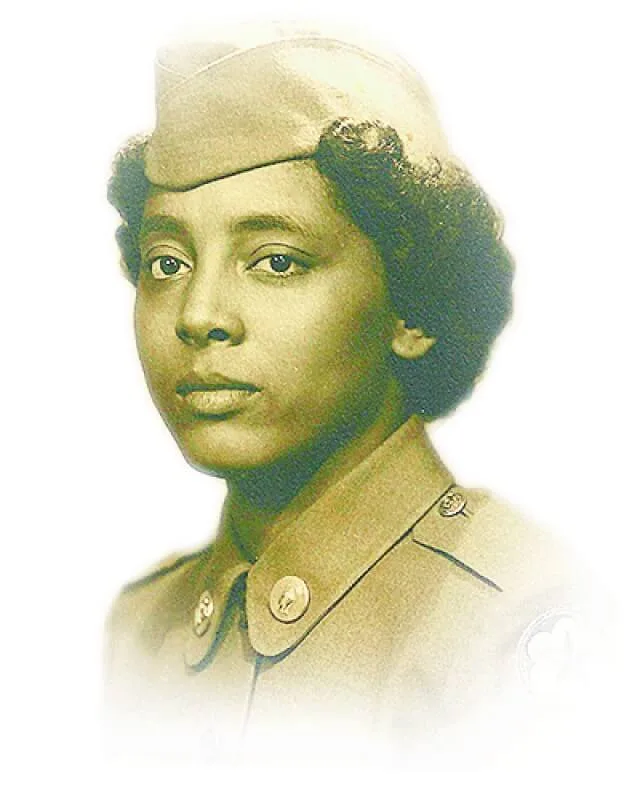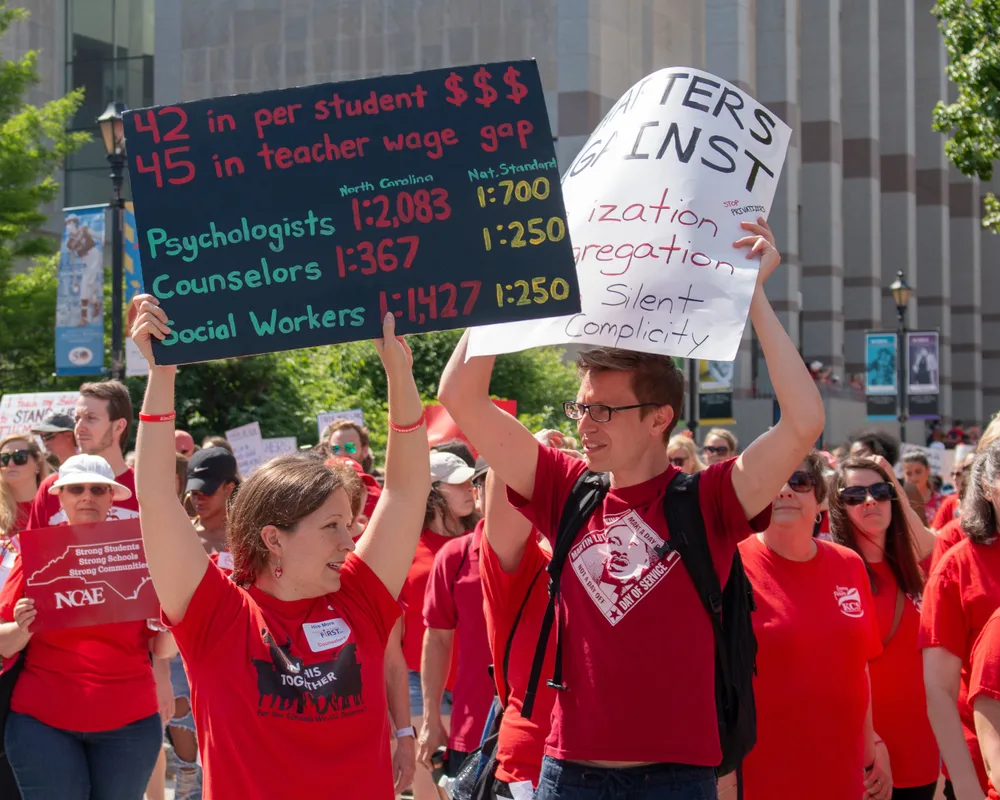
Sarah Keys Evans was serving in the Women's Army Corps in 1952 when she was arrested after refusing to give up her bus seat for a white Marine at the Roanoke Rapids bus station. Her lawsuit would go on to change the country. (Image via US Army.)
Black History Month is upon us once again. Don’t overlook some of our state’s most significant moments.
There are plenty of significant events that occurred right here in North Carolina that aren’t widely known. That’s why we took some time during this month, Black History Month, to delve into four significant and powerful moments in North Carolina’s Black history.
After all, this is North Carolina’s shared history and one that we need to continue to talk about, understand, and recognize to help us navigate and improve our state and world today.
NC’s Multiracial Government, 1894-1900
For a brief period of time — just six years — North Carolina had a coalition of Black and white political leaders band together decades after the Civil War to increase access to the ballot for Black and white citizens alike, and strengthen the state’s public education.
The “Fusionist” years, a few decades after the Civil War, marked a short-lived alliance between the Populist and Republican parties in the state from 1894 to 1900. The two groups banded together to defeat Democrats, which at the time was the party of white supremacy in North Carolina and across the South.
The Populists drew from largely white working farmers in the mountains and Piedmont. That era’s Republican Party included white and Black men in their ranks, many from eastern North Carolina. More than 1,000 Black elected or appointed officials took office locally and in the state during those years, a trend that would reverse as the oppressive “Jim Crow” rules of segregation were written into the state’s laws in the decades that followed.
North Carolina’s US Rep. George Henry White was the only Black man serving in Congress at that time. In 1901, he warned of white supremacy’s resurgence in the South and in North Carolina. This came a few years after violent insurrectionists inflamed by white supremacy campaigns toppled Wilmington’s multiracial government in 1898. The Wilmington Massacre is, to date, the only coup in US history. Its leaders would hold power in the state for decades after.
“The only apology that I have to make for the earnestness with which I have spoken, is that I am pleading for the life, the liberty, the future happiness, and manhood suffrage for one–eighth of the entire population of the United States,” White told Congress in his 1901 farewell speech. Jim Crow laws forced White out of political office and, eventually, the state.
White left to start a law practice in Washington, D.C., in 1901. He also founded an all-Black community named Whitesboro on the New Jersey shore.
How This NC Woman Challenged Bus Segregation, and Won
When Sarah Keys’ bus came through the Roanoke Rapids bus station on Aug. 1, 1952, her refusal to leave her seat would serve as an underpinning of the civil rights movement.
Her actions that day, and her subsequent decision to call out the wrongs of segregation through the courts, would pave the way for the dismantling of segregation in Southern states like North Carolina.
Keys, a Black woman serving in the Women’s Army Corp in New Jersey, was taking a bus back to her eastern NC hometown of Washington — or “little” Washington as it is known to locals — in 1952 when a driver told her to move to the back of the bus to make room for a white Marine.
Keys refused, and she was arrested for disorderly conduct. With lawyers from the NAACP representing her, Keys filed a lawsuit against the Carolina Coach Company, challenging the bus company. The nation’s transit authority, the Interstate Commerce Commission, would go on to rule that segregation was prohibited on buses like the one Keys rode.
The decision in Keys v Carolina Coach Co created an important legal precedent, although Keys’ role was soon overshadowed by the Montgomery bus boycott. But the case would be used years later by the late US Attorney General Robert Kennedy when he called for resources to protect the Freedom Riders in 1961 who had been bloodied and attacked in their push to challenge Southern segregation.
Sarah Keys, who uses her married name of Sarah Keys Evans, is now 92 years old and lives in New York City.
Her role in the civil rights movement went unrecognized for too long. That’s one reason why Rodney D. Pierce, an 8th grade social studies teacher in Nash County, worked to have her contribution recognized. The state erected a historical marker this year near where the Roanoke Rapids bus station once stood in Halifax County.
“I wanted to do my part to make sure those leaders get recognized when they’re still with us,” Pierce said. “It’s so important to do when we have matriarchs from the movement that are still around.”
Leading Student Civil Rights Group Formed
It was at Raleigh’s Shaw University where one of the leading civil rights groups got its start. The Student Non-Violent Coordinating Committee, or SNCC, was formed on April 15, 1960 when more than 150 student leaders from 10 states around the country gathered on Shaw’s campus to coordinate efforts to confront and dismantle segregation.
The meeting came just two months after four NC A&T students held a sit-in at the Woolworth lunch counter in Greensboro. The new group, headquartered in Atlanta, would go on to become a key force in the civil rights movement as young people and college students used non-violent tactics to confront injustice.
“Unlike mainstream groups, which merely sought integration of blacks into the existing order, SNCC sought structural changes in American society itself,” said Julian Bond, the late civil rights leader, about the role the group played.
Hyde County Schools Boycott
Three Black teenagers began a 1968 school boycott in this rural coastal county that led to lasting change in their community. It was also one of the longest sustained protests in the state.
The yearlong school boycott was started by Black teenagers and joined by parents who pulled their children out of the county schools. It came as white-controlled communities across the South resisted pressure from the courts and the federal government to integrate public schools.
In Hyde County, a white-dominated school board came up with their own integration plan without input from the county’s Black community. That initial plan, not surprisingly, would have further disadvantaged Black children by shutting down the county’s two existing Black schools, instead sending children to one consolidated school that previously served just white children.
That would have meant long distances for Black children in the country to travel to school. It might have also cost some Black teachers their jobs, and closed two local schools that the community’s Black residents were proud of.
The yearlong boycott included daily protests, marches to Raleigh, and even a violent gun battle with Ku Klux Klan members. The movement, which was led by teenagers at its start, faced tear gassing and arrest as people rallied around the cause. Black churches opened their doors “movement schools” for boycotting students, and the Hyde County protest attracted national attention.
The months-long boycott ended with a desegregation plan that kept the county’s two existing Black schools open, making them elementary schools. One formerly all-white school was converted into a high school for all students.
You can read more about the Hyde County school boycott here and here.
This story originally ran in February 2022.
Politics

Emergency rooms refused to treat pregnant women, leaving one to miscarry in a lobby restroom
By AMANDA SEITZ Associated Press WASHINGTON (AP) — One woman miscarried in the lobby restroom of a Texas emergency room as front desk staff refused...

‘Unfit to be our next governor’: NC basketball greats speak out against Mark Robinson’s run for governor
NC has a long history of greatness on the basketball court. Now college basketball players from UNC, NC State, and Duke are wading into politics....
Local News

Good News Friday: It’s a good day to be a fan of the NC State Wolfpack
The men's and women's teams will compete for a national championship in college basketball this weekend. Plus: How to watch the solar eclipse, and...

The zodiac signs of 12 iconic women offer insight into their historic accomplishments
Zodiac signs can tell you a lot about someone’s personality. Whether they’re an earth, water, air, or fire sign, these 12 categories (which are...




